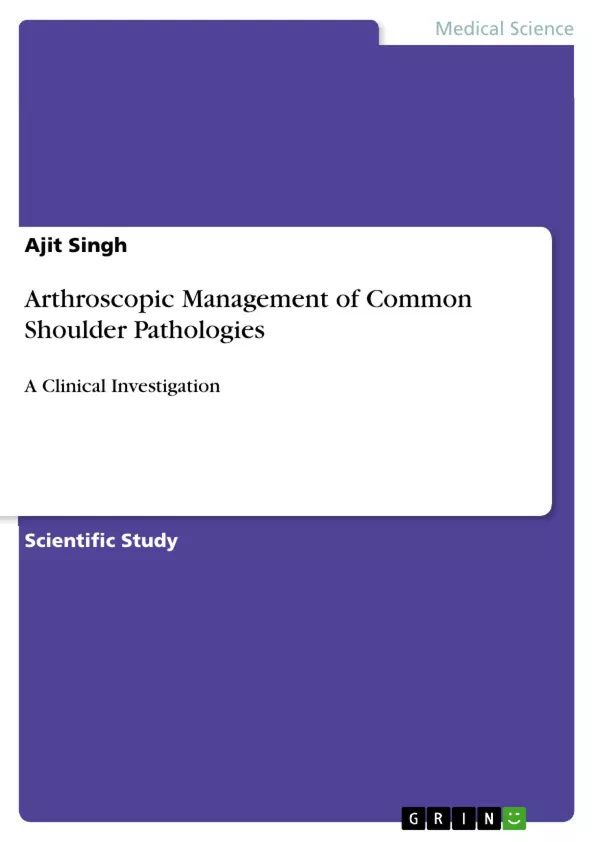This work provides a comprehensive overview of the study "Arthroscopic treatment of common shoulder pathologies", which deals with the role of arthroscopy in the diagnosis and treatment of various shoulder diseases. It is ideal for professionals, students and researchers in the field of orthopaedics and sports medicine.
The study begins with a thorough introduction to the subject and looks at the detailed anatomy of the shoulder complex. This is followed by a discussion of the biomechanics of the shoulder, which is essential for understanding pathologies and their treatment. A comprehensive literature review presents previous research findings and forms the basis for the subsequent discussion of the fundamentals of shoulder arthroscopy, including positioning and portal anatomy.
The study describes the arthroscopic anatomy of the shoulder joint in detail, which is essential for the practical application of arthroscopy. Methods used in the study are explained in a separate chapter. This is followed by an analysis based on the age and gender of the patients, which helps to identify specific risk factors.
The discussion and analysis of the results provides new insights into the effectiveness of arthroscopic treatment. Finally, the key findings are summarised and conclusions drawn, followed by an extensive reference section that underpins the scientific depth of the study.
Inhaltsverzeichnis (Table of Contents)
- INTRODUCTION
- ANATOMY OF THE SHOULDER COMPLEX.
- BIOMECHANICS.
- REVIEW OF LITERATURE
- SHOULDER ARTHROSCOPY: BASIC PRINCIPLES OF POSITIONING, AND PORTAL ANATOMY...
- ARTHROSCOPIC ANATOMY OF SHOULDER JOINT.
- MATERIAL AND METHODS
- AGE AND SEX
- DISCUSSION.
- SUMMARY AND CONCLUSION.
- REFERENCES
Zielsetzung und Themenschwerpunkte (Objectives and Key Themes)
This study aims to evaluate and assess the role of arthroscopy in various shoulder pathologies, both for diagnostic and therapeutic purposes. The study highlights the advantages of arthroscopy compared to open surgical techniques, showcasing its benefits in terms of smaller incisions, less pain, and faster recovery.
- The Evolution of Arthroscopic Techniques in Shoulder Surgery
- Arthroscopic Management of Common Shoulder Pathologies
- The Benefits and Limitations of Arthroscopic Procedures
- The Role of Arthroscopy in Diagnosing and Treating Various Shoulder Conditions
- The Importance of Arthroscopy in Improving Patient Outcomes
Zusammenfassung der Kapitel (Chapter Summaries)
- Introduction: This chapter introduces the study's focus on arthroscopic management of shoulder pathologies. It discusses the limitations of shoulder articular cartilage and the emergence of arthroscopy as a primary treatment modality.
- Anatomy of the Shoulder Complex: This chapter provides an overview of the anatomical structures involved in the shoulder joint, laying the groundwork for understanding shoulder pathologies and their treatment.
- Biomechanics: This chapter delves into the biomechanics of the shoulder joint, explaining the movement mechanisms and forces involved, which helps to understand the causes and consequences of shoulder injuries.
- Review of Literature: This chapter presents a comprehensive overview of existing research on arthroscopic management of shoulder pathologies. It analyzes trends, outcomes, and the evolution of techniques.
- Shoulder Arthroscopy: Basic Principles of Positioning, and Portal Anatomy: This chapter focuses on the practical aspects of shoulder arthroscopy, outlining the essential principles of positioning, portal anatomy, and surgical techniques.
- Arthroscopic Anatomy of Shoulder Joint: This chapter explores the detailed anatomy of the shoulder joint as visualized through arthroscopy, providing a deeper understanding of anatomical landmarks and potential pathologies.
- Material and Methods: This chapter details the methodology employed in the study, including patient selection, surgical procedures, and data collection methods.
- Age and Sex: This chapter examines the demographic characteristics of the study participants, highlighting any relevant age or sex-related factors that may influence outcomes.
Schlüsselwörter (Keywords)
The study focuses on the key concepts of shoulder arthroscopy, its application in diagnosing and treating a range of pathologies, and its impact on patient outcomes. This includes key terms such as arthroscopic management, shoulder pathologies, impingement syndrome, rotator cuff tear, labral lesions, instability, and arthroscopic techniques.
- Quote paper
- Ajit Singh (Author), 2017, Arthroscopic Management of Common Shoulder Pathologies, Munich, GRIN Verlag, https://www.grin.com/document/919839



